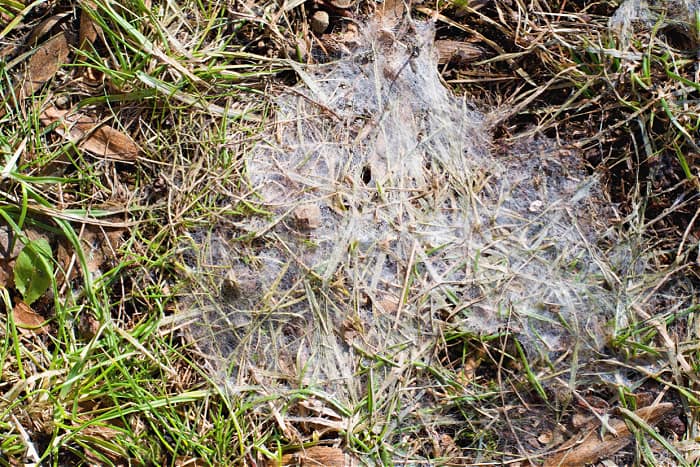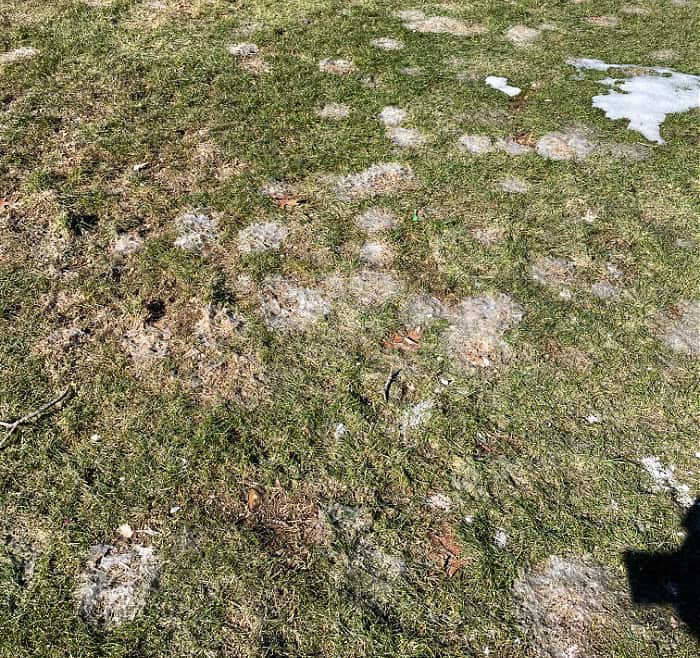Although snow mold can look scary, there’s actually some pretty simple ways to prevent it and treat it.
For the most part, a light covering of snow over your cool season lawn is actually beneficial during the winter months. The snow cover protects the lawn from drying out due to wind. It also helps insulate the soil from extreme cold temperatures, and provides valuable moisture to the roots in early spring when soil temps begin to warm. Despite it’s benefits though, snow cover does pose a small issue. It blocks air flow, and whenever you block air flow in your lawn it can create fungus issues. In this case, that fungus is Snow Mold.
What is Snow Mold
Snow Mold is a fungus that effects cool season grasses. There are two types: Gray, and Pink. For the most part, as a homeowner you’re more likely to encounter Gray Snow Mold, which is less damaging. Pink snow mold, which is typically found in golf courses where there is bent grass, is more likely to cause irreparable damage since it can damage the roots, and crown of the grass.
Snow mold flares up with cooler soil temps, matched with increased moisture and decreased air flow due to snow cover. The fungi are most likely in your soil all year and only become a problem when conditions become ideal.
What Does Snow Mold Look Like
Snow mold will become noticeable in late winter/early spring when snow melts and your lawn becomes exposed. With Gray Snow Mold, you’ll notice gray or white circular patterns that can combine to leave large patchy sections. You’ll probably notice in these areas the grass is matted down. Also in infected areas, you may see what appears to be spider webs (see pic below). This is called mycelium or ‘fungal webbing’ and it has nothing to do with spiders. It’s actually the vegetative part of a fungus that uses this web like branching system to transfer water and nutrients.

Pink Snow Mold looks very similar but as the name implies it usually appears more pink. You’re more likely to identify it later in the spring since infected areas may continue to be brown as the rest of your lawn greens up. With Gray Snow Mold on the other hand the infected areas are very likely to recover and green up with the rest of your lawn. But once again, the typical homeowner is more likely to have the less problematic Gray Snow Mold.
Treatment
It sounds really simple, but the best thing you can do if you have snow mold is to gently rake matted down sections of grass to increase air flow to the soil. This can be done in early spring when snow has melted and your soil is no longer frozen. At this point your lawn should be starting to come out of dormancy.
Don’t use a metal garden rake for the job, instead use a light spring rake (metal or plastic) and just make a couple of passes over the area to prop up the matted down grass.
As the rest of your lawn starts to wake up you should notice the infected areas start to green up as well. It won’t take long for the snow mold to disappear. Also, once you start your lawn care program and apply your first round of nitrogen fertilizer, signs of snow mold will quickly fade.
Prevention
1. Cut low for the last mow of the season
When your grass is done growing for the year and it’s time for one last mow, drop the cutting height at least a notch or two. During the fall you should be gradually decreasing your mowing height. When it’s time for the last cut of the season bump it down even further, but not so low that it scalps the lawn. Mowing low will help keep grass standing tall instead of flopping over when it snows.
2. Collect leaf litter and clippings.
Remember, you want to do everything possible to not smother your lawn before the snow flies. Rake or suck up leaves, and if you can bag the last mow of the season than definitely do it. Clippings and leaves won’t have time to break down before the snow comes. Leaving them on your lawn at the end of the season will have the same negative effects as matted down grass.
3. Remove thatch.
If you have a thatch problem heading into winter, there’s no doubt it’ll increase your odds of getting snow mold. Tine rake dethatching, or power raking may be necessary depending on the type of thatch problem you have. For everything you need to know about thatch check out: Lawn Dethatching
4. Apply high nitrogen fertilizer, late in the season.
Many people refer to this as a Winterizer. Applying a high nitrogen, quick release fertilizer at the end of the season will help your lawn recover from snow mold in early spring. Your lawn will store the nitrogen and use it in the spring when soil temps increase.
5. Apply a preventative fungicide.
Applying liquid Propicanozole at a rate of 3 ounces per 1000s/f before the snow falls will help prevent snow mold. Personally, I would only recommend this if you are concerned with Pink Snow Mold. If you’re near a golf course or have bent grass than this may be worth it for you. Otherwise, since fungicides can be expensive you may want to consider this as a last resort, especially for Gray Snow Mold since your lawn is very likely to naturally recover from it.
6. Avoid snow piles.
Under large piles of snow is most likely where you’ll see problem areas. Heavy snow piles cause grass to flop over and they also stay on the grass longer since it takes longer to melt in the spring. If snow plowing or shoveling, try and use non lawn areas for piling snow as much as possible.
Check Out These Posts Next
Treating and Preventing Lawn Fungus
3 Product Lawn Care Program- Cool Season Lawns
Lawn Care Program for Warm Season Lawns
Winterizer Fertilizer: Everything You Need to Know
Lawn Dethatching: Everything You Need to Know
Follow Me
Join my free email list!
Plus, follow me on Facebook, Instagram, and Pinterest.



I see snow mold often because we live in an area where there is a lot of moisture on the ground in the Fall. There’s a stream that runs through our property and it can make the area around it quite wet at times. I love knowing that there is a way to help prevent this from happening to our lawn and also a way to treat it after it does. This is a very helpful post. Thank you so much!!!!
I’m so happy you enjoyed the post Jenny! I agree, it’s definitely nice to know when there’s an easy fix.
Great info Mark… I was real worried about this last spring and like you said, since it was grey snow mold it didn’t really leave a lasting impact. I’m going to follow your advice and cut short next week when I do my last mow of the season. I’ll throw the bagger on the mower too.
Thanks Pete! It’s true, of all the problems this one is usually pretty easy to deal with.